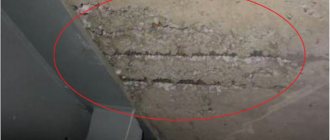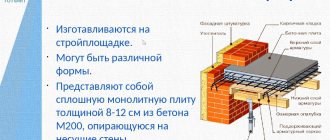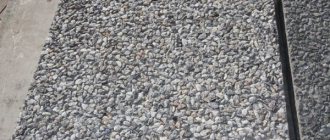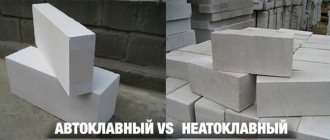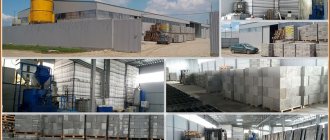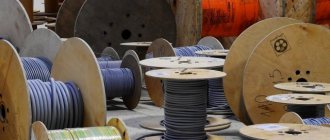Technology for the production of reinforced concrete structures
Concrete is an artificial stone material obtained as a result of compaction and hardening of a concrete mixture of a given mobility, consisting of a mineral binder, water, fillers and additives.
The production of concrete and reinforced concrete products includes the following technological stages :
incoming quality control of all materials used (binders, fillers, additives, reinforcement, embedded parts, etc.); calculation of the composition of the concrete mixture and its laboratory testing; preparing concrete mixture at a factory or construction site; transporting it to the place of manufacture of the structure; laying in shape (formwork) and compaction; concrete hardening; opening the form (removing the formwork); sending finished products to the construction site or finished product warehouse.
The calculation of the composition of the concrete mixture is carried out using graphs and tables based on the following data: operating conditions of the future structure, taking into account which the necessary starting materials are selected; components quality indicators; designed concrete class; mobility of the concrete mixture, which is selected depending on the size of the structure being concreted, the density of the reinforcement and the method of compaction. The correctness of the calculation is checked in laboratory conditions to ensure that the mobility of the mixture and the strength of concrete correspond to the specified values.
Based on the manufacturing method, structures are divided into monolithic and prefabricated. When concreting monolithic structures: foundations, walls, floors, hydraulic structures, road surfaces, the concrete mixture is prepared at the factory (ready-mix concrete) and transported to the place of laying at the construction site, where the concrete hardens under natural conditions. Prefabricated structures (beams, slabs, columns, panels, trusses, etc.) are produced at specialized factories (concrete products, reinforced concrete materials, KSM) from where they are transported to the construction site for installation.
Preparation of a concrete mixture includes the preparation of materials, their dosing and mixing in special concrete mixers. The resulting concrete mixture must have cohesion, homogeneity and workability (formability)
.
Workability control is carried out according to two indicators: mobility and rigidity. Workability is determined for plastic concrete mixtures by measuring the slump in centimeters of a molded truncated standard cone. This indicator is a static characteristic of the structural strength of the concrete mixture, because its settlement occurs under the influence of its own mass. Depending on the value of the cone settlement (OC), there are low-plastic mixtures of OK 1 - 9 cm, plastic ones - OK 10 - 20 and cast mixtures - OK more than 20 cm. With a cone settlement value of less than 1 cm, workability is characterized by rigidity. Stiffness is a dynamic indicator of the viscosity of a concrete mixture, because when determining it, mechanical action is used - vibration, under the influence of which the molded concrete mixture evenly fills a certain volume.
If the required vibration time is from 5 to 40 s, the mixture is hard; if it is more than 40 s, it is super hard. Workability depends on the volume and viscosity of the cement paste, which ensures cohesion and homogeneity of the mixture, as well as the porosity, size and shape of the aggregate. With a high water content, the viscosity of the cement paste decreases and does not ensure a uniform weighted distribution of the aggregate throughout the entire volume, and therefore, separation of the concrete mixture is observed and, as a consequence, heterogeneity in the properties of concrete in the structure.
The water separation observed in this case leads to the formation of a porous, defective structure, especially the surface layer of concrete. Such negative phenomena are most often observed during the preparation and especially transportation and compaction of plastic, cast mixtures. Therefore, to increase their homogeneity and cohesion, the consumption of cement is increased, plasticizers and superplasticizers are introduced, the consumption of fine aggregate is increased, or mineral water-retaining, hydrophilic additives such as bentonite clay are used.
To obtain high-grade concrete, concrete mixtures with low water content are used. Their high-quality workability is ensured by increasing the size of aggregates, the absence of flaky and needle-like grains in crushed stone, and the introduction of plasticizers and superplasticizers.
After preparation, the concrete mixture is transported to the placement site. On the territory of the plant, bunkers and concrete distributors are used for this purpose; to produce monolithic reinforced concrete, dump trucks, concrete mixer trucks, and concrete trucks are used. One of the progressive methods of continuously supplying concrete mixture to construction sites, landfills and plant workshops is transportation through pipelines using special concrete pumps.
The mixture is fed into a cleaned and greased form or formwork, into which reinforcement is installed according to the design. After filling the volume, the concrete mixture is compacted to ensure uniform distribution and give the desired shape and size. The main methods of compaction are associated with vibration, under the influence of which the thixotropic properties of the mixture are manifested - the ability to reduce viscosity (liquefy) as a result of a breakdown of adhesion between components under the influence of vibration and restore structural integrity and strength after removing the mechanical impact.
When concreting monolithic structures, plastic mixtures are used, which are compacted with deep and surface vibrators. Prefabricated reinforced concrete structures are made from high-class concrete, therefore, to compact super-hard and rigid concrete mixtures, more massive impact is used using a weight: vibratory rolling and vibratory stamping
.
For low-plasticity and plastic mixtures, vibration and vibration-free - impact
,
based on the cyclic rise of the form with the mixture and the fall from a given height. Cast mixtures fill the mold under the influence of their own mass ( filler ). In order to accelerate hardening and increase strength, additional vibration-vacuuming
,
which allows, due to the created difference in the upper and lower pressure relative to the surface of the product, to remove part of the water, increasing the density of concrete. For the manufacture of hollow products (pipes, columns), a centrifugal molding method is used, based on uniform distribution over the inner surface of a rotating mold and compaction of the supplied concrete mixture under the influence of centrifugal force.
To protect the concrete surface and produce durable thin-walled structures, the rammed method , which involves feeding a concrete mixture under pressure into a mold or onto the surface of the structure - shotcrete concrete . Concrete road products: curb stones, paving slabs have high requirements for wear resistance and frost resistance. To ensure the specified properties, it is necessary to work with super-rigid concrete mixtures or with dry ones, laid and compacted by pressing in forms in a dry state, followed by extremely minimal water saturation with steam or a solution of chemical additives. Thus, products are obtained with strength up to 80 MPa, water absorption of less than 2%, frost resistance of more than F1000 and low abrasion.
After molding, the concrete in structures hardens and acquires the designed strength of artificial stone. The hardening mode depends on the method of obtaining structures: monolithic
–
in natural conditions
,
prefabricated
–
using thermal and humidity treatment at normal and high pressure in autoclaves.
Depending on climatic conditions, monolithic structures harden at low positive and negative temperatures, positive optimal 20±5ºС and at high temperatures and low humidity. Since the intensity of the hardening (hydration) process depends on temperature and humidity conditions, each mode has its own technological features.
To ensure hardening at low positive temperatures, it is necessary to use high-quality quick-hardening cements, hardening accelerator additives or complex additives consisting of accelerators and plasticizers, which allow accelerating the development of strength by reducing water consumption. Due to the transition of water at negative temperatures into a solid-phase crystalline state, which excludes the possibility of chemical hydration reactions, winter concreting methods involve the use of a certain type of energy to preserve water in a liquid state.
Depending on the type of energy used, methods are divided into unheated and heated . The first ones use the energy of cement hydration - the “thermos”
or the ability of some salts (NaCl, CaCl2, K2CO3) when dissolved in water to reduce the freezing point of the solution
-
the method
of antifreeze additives
. Using the “thermos” method, massive reinforced concrete foundations are obtained, protected on three sides by a layer of earth and on the fourth, the outer side, by slab heat-insulating material of a certain calculated thickness. To accelerate the development of strength, fast-hardening cements and hardening accelerator additives are used, or the initial temperature of the concrete mixture is increased before placing it in the formwork by heating water and aggregates at the factory or short-term electrical heating using electrodes directly at the construction site.
The amount of antifreeze additive introduced depends on its material composition and the minimum outside air temperature in the first seven days of concrete hardening. To prevent freezing of water, the concrete surface is covered with waterproofing materials.
Heating methods involve heating the concrete:
- contact method using steam energy passed through special metal compartments located along the perimeter of the structure - steam heating ;
- warm air from a heated device (for example, a heater) supplied to a closed volume above a concrete structure, limited by film or sheet material - the greenhouse method ;
- using electrical energy, which is converted into thermal energy due to the electrical resistance of the material. Electrical heating is carried out by passing an electric current through the concrete mixture between two electrodes, passing the current through reinforcement or a metal mold. In the first case, due to electrical resistance, the concrete mixture itself is heated, in the second, the concrete mixture is heated from the heated surface of the reinforcement or mold.
The purpose of all of the above methods is to ensure that concrete gains “critical” strength , amounting to 25–50% of the brand strength, which will allow it to withstand subsequent freezing when the temperature drops without destruction.
The most favorable conditions for concrete hardening using hydraulic binders are natural (summer).
At high temperatures and low humidity, there is a loss of mobility of the ready-mixed concrete mixture before laying in the formwork, a sharp dehydration of the surface layer of concrete, and then the internal ones as a result of mass transfer processes. This leads to the formation of a defective porous structure and the appearance of cracks on the surface. Therefore, hardening inhibitor additives are introduced into the transported concrete mixture or the temperature of the mixture is lowered (for example, by partially replacing water with ice). When producing small volumes of concrete mixture directly on the construction site, on the contrary, hardening is accelerated to prevent water evaporation through the use of quick-hardening cement, accelerator additives and gel processing using black film or special forms that focus and then release solar energy.
In order to reduce shrinkage deformations, the molded concrete surface is protected with film materials or a layer of wet sawdust.
When producing prefabricated reinforced concrete structures, acceleration of the strength gain of concrete is achieved by using heat treatment in an atmosphere of saturated steam. When working with cement concrete based on varieties of Portland cement, thermal moisture treatment (TMT) is used at normal pressure and temperature up to 95%. For silicate concrete with lime-siliceous binder and subject to the development of grade strength by cement concrete - autoclave treatment at temperatures up to 203ºC and pressure up to 1.6 MPa.
The heat treatment mode includes the following stages: at normal pressure - holding until setting begins, raising the temperature to maximum, isothermal heating, cooling; during autoclave processing - holding until setting begins, raising the temperature to 100ºС, raising the temperature and pressure to maximum values, holding, reducing the temperature to 100ºС and pressure to normal, cooling.
The holding time and the rate of rise in temperature and pressure depend on the activity of the cement, the hardness of the concrete mixture and the type of additives introduced. When using highly active cement, a concrete mixture with low water content and hardening accelerator additives, the holding time is reduced and the rate of temperature and pressure rise increases. The maximum temperature is determined by the activity of the binder, the holding time is determined by the required strength of the concrete at the output, which, with HPT, can be, at the request of the customer, from 50 to 70% of the branded concrete. While maintaining the general consistency of the technology for producing prefabricated reinforced concrete, depending on the shape, size, weight and complexity of the structure, the following production methods : flow-unit, conveyor and stationary (bench, cassette, block) .
According to the first method, which is used in the production of multilayer panels, the mold with concrete is moved by crane from one technological station to another. Using the conveyor method, the simplest flat structures are produced, located in molds on a moving metal belt. The peculiarity of the stationary method is the use of stationary large-sized forms equipped with steam jackets for HME and mounted vibrators for compacting the concrete mixture. This technology is used in the production of large-sized trusses, beams (bench), partition slabs in multi-sectional vertical cassettes (cassette) and large-sized blocks for one and two rooms (block).
In order to increase the strength of concrete in structures working in tension and bending, prestressed reinforcement is used or prestressing cement is used as a binder. The tensioning of the reinforcement with the fastening of the ends is carried out using the mechanical or electrothermal method. The prestressed reinforcement prepared in this way is either fixed according to the design in a mold and filled with a concrete mixture or pulled through specially created channels in hardened concrete, followed by filling them with cement-sand mortar. After gaining a certain strength, the ends of the reinforcement are released, transferring the concrete to a compressed state, allowing it to withstand higher bending-tensile loads.
Organization of production of concrete and reinforced concrete products at landfills
The bench method for the production of reinforced concrete products is characterized by the fact that the product during the production process (from the beginning of its molding to the moment of stripping) remains motionless, and the equipment (for example, a concrete paver, vibrator) moves from one manufactured product to another. Products are molded on an open concrete stand or directly in steaming floor or pit chambers. The concrete mixture is compacted using the bench method using deep or surface vibrators.
| Technological schemes for the production of reinforced concrete products at landfills using bench ( a ) and flow-unit ( b ) methods |
| 1 — stand; 2 - place for preparing molds and laying reinforcement; 3 - molding unit; 4 — steaming chambers; 5 - place for stripping products; 6 – finished products warehouse |
The bench method makes it possible to produce large-sized structures and quickly organize the production of reinforced concrete products. However, it requires large production areas with little mechanization of production processes, which leads to high labor costs.
The flow-aggregate method for the production of reinforced concrete products , used at large landfills, is characterized by the fact that during the manufacturing process, products are moved one after another through a number of posts equipped with various units or devices. The duration of stay of products at individual posts varies: from several minutes when vibrating products on a vibrating platform to several hours in a steaming chamber.
At the first post 2, the mold is installed, lubricated, then the reinforcement and embedded parts are laid. On the second 3, the mold is filled with concrete mixture, it is compacted and the surface of the product is smoothed. On the third 4, heat and humidity treatment of products is carried out or they are kept in open areas without heating, on the fourth 5, the products are stripped and inspected. If the product is manufactured with immediate stripping, then the fourth post is not needed. The product is moved from one post to another by mobile cranes or on trolleys.
Based on their purpose and equipment, proving grounds for the production of prefabricated concrete and reinforced concrete products are divided into complex, near-factory and adjacent.
Complex landfills have a concrete mixing plant with warehouses for aggregates and cement, reinforcement and mechanical workshops, a workshop for making and repairing molds, a technological line for molding products, a warehouse for finished products, installations for providing the landfill with electricity, water and steam, an office and a laboratory.
The factory and construction sites consist of a technological line for molding products (stands, cranes, equipment for laying concrete mixtures), a warehouse for finished products and the necessary communications.
Polygons can be open or combined. At combined sites, concrete mixture is prepared and products are molded indoors, and heat treatment is carried out in an open area.
The plant's polygons are part of the reinforced concrete products plant and are used for the production of a small number of standard sizes of products. Thanks to them, plant productivity increases. As a rule, the plant's landfill is supplied with concrete mixture from the plant's concrete mixing plant.
Attachment ranges operate mainly according to the bench scheme and are intended in most cases for the manufacture of large-sized products. They are built near the structures being built and equipped with self-propelled cranes to perform loading and unloading operations.
Such landfills are usually supplied with concrete mix from the central construction concrete plant. It is delivered by dump trucks. The reinforcement is supplied from a reinforcement factory or from construction workshops.
- Concrete science
- Manufacturing technology of prefabricated reinforced concrete structures and parts
- Concrete work in winter conditions
- Production of prefabricated structures and parts from lightweight concrete
- Production of prefabricated products from dense silicate concrete and concrete with clinker-free binder
- Production of concrete and reinforced concrete products at landfills
- Organization of production
- Types of concrete and reinforced concrete products
- Forming and hardening of reinforced concrete products
- Manufacturing of certain types of reinforced concrete structures and products
- Quality control of manufactured reinforced concrete products
- Safety precautions in the manufacture of reinforced concrete products
- General safety rules and fire prevention measures at a construction site
